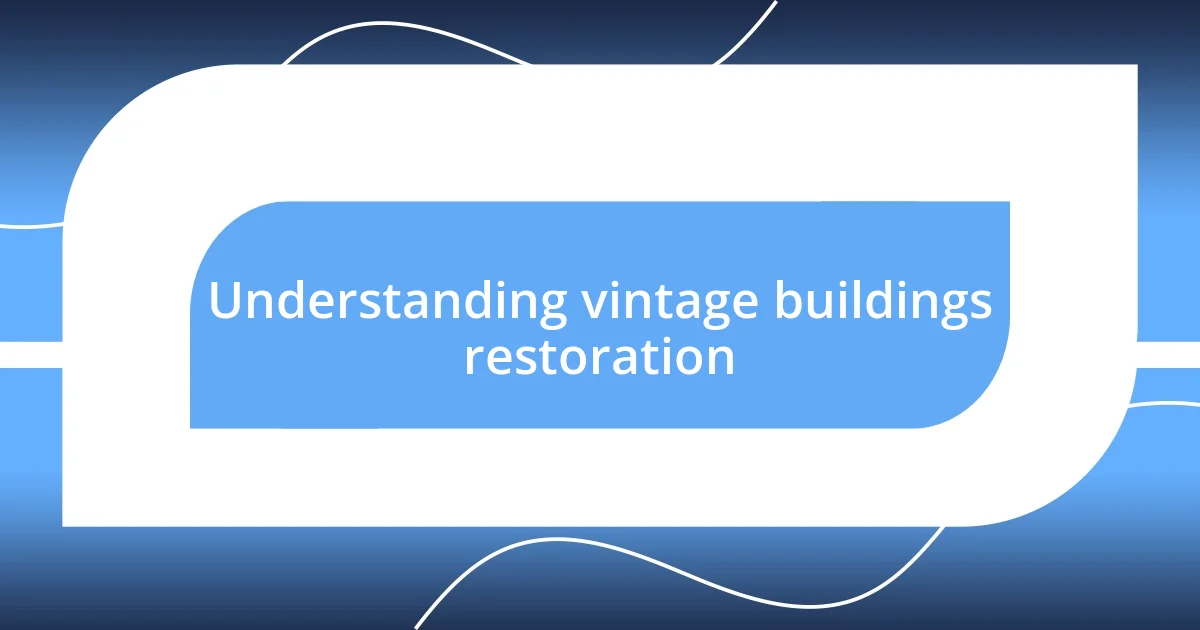Key takeaways:
- Restoring vintage buildings involves a blend of historical appreciation and modern functionality, allowing for meaningful preservation while enhancing contemporary living.
- Thorough planning and research, including examining old blueprints and creating checklists, are crucial for maintaining authenticity and managing the restoration process effectively.
- Engaging with the community and hiring skilled professionals who understand the nuances of historical sites enhances the restoration journey, fostering sustainability and deepening connections to the building’s history.

Understanding vintage buildings restoration
Restoring vintage buildings is both an art and a science. Each structure holds its own unique story, and I remember the thrill of uncovering hidden features once obscured by layers of paint and time. Have you ever felt that rush when peeling back the past to reveal a lost treasure?
It’s essential to appreciate the original craftsmanship that went into these buildings. For me, the moment I discovered handmade bricks in the fireplace of an old cottage was a revelation. It reminded me of the many hands and hearts that had shaped it before me, which adds a layer of emotional depth to the restoration process.
Throughout my journey, I’ve often grappled with the challenge of blending modern conveniences with historical accuracy. Do you prioritize historical fidelity or contemporary functionality when restoring? I found that striking the right balance not only preserves the building’s history but also allows it to thrive in today’s world—creating a living testament to both the past and the present.

Planning the restoration process
Planning the restoration process is a crucial step that requires careful consideration. It’s like mapping out a journey where each decision contributes to the final destination. When I began my restoration project, I spent countless hours researching the building’s history. This research allowed me to identify the original materials used, which later guided my choices to maintain authenticity.
I vividly recall one instance during the planning phase where I stumbled upon old blueprints in a local archive. The thrill of holding those fragile, yellowed papers felt like connecting with the past. They not only provided a blueprint for restoration but also sparked the realization that each room told a story—what was once a kitchen had a quaint little window perfect for a herb garden! This insight helped shape my design choices, ensuring that I honored the building’s soul while also making it practical for modern living.
To streamline the planning, I created a checklist that broke down tasks into manageable steps. This method kept me focused and motivated. Have you ever tackled a big project without a plan? It’s easy to feel overwhelmed! I found that organizing everything from structural repairs to aesthetic updates allowed me to celebrate small victories along the way while ensuring I stayed true to the building’s character.
| Planning Element | Importance |
|---|---|
| Research | Understanding history and structure |
| Adherence to original materials | Maintaining authenticity |
| Creating a checklist | Organizing tasks for clarity |

Assessing the building’s condition
Assessing the building’s condition is a critical first step in any restoration project. I remember the day I stepped inside that old Victorian house—dust particles danced in the sunlight streaming through cracked windows. The ambience was hauntingly beautiful, but I knew I had to dig deeper. With every creak of the floorboards, I felt like I was uncovering layers of history, but I had to be cautious. I quickly realized that a thorough inspection could reveal not only the charm of the building but also areas in dire need of attention.
When assessing a vintage building, it’s important to evaluate several key aspects:
- Structural integrity: Check for signs of foundation damage, shifting walls, or sagging roofs.
- Roof condition: Look for leaks, missing shingles, or sagging eaves that could lead to bigger issues.
- Moisture damage: Inspect areas for mold or rot, particularly in basements and attics.
- Electrical systems: Determine if the wiring meets current safety standards and if any updates are necessary.
- Plumbing systems: Check for leaks and evaluate the age and condition of pipes.
Making these assessments not only armed me with knowledge but also allowed me to prioritize which elements of the restoration required immediate attention. I distinctly remember walking past a particularly battered doorway and feeling a mix of despair and determination. This wasn’t just a building; it was a canvas waiting for revival. Understanding these issues gave me focus, guiding me toward the next steps of the project while preserving the essence of its history.

Choosing the right materials
Choosing the right materials requires more than just a basic understanding; it hinges on a deep appreciation for the building’s character. During my search for authentic materials, I encountered an old supply catalog from the 1920s. Flipping through its pages felt like being transported back in time; I could almost hear the creaking of tools and feel the artists’ hands shaping those original fixtures. Isn’t it fascinating how something as mundane as a light switch can tell a story? I chose to replicate the vintage style to honor that history and ensure every detail felt cohesive.
There were moments when the options seemed overwhelming. While shopping for tiles, I remember standing in front of a wall of choices, each more beautiful than the last. I felt an inexplicable attachment to the weathered patina of reclaimed wood and the vibrant hues of vintage tiles. I realized that it was essential not only for aesthetics but for capturing the spirit of the building. By choosing materials that echoed its past, I created a bridge between history and modern utility.
However, it’s not just about aesthetics; durability matters too. As I wrestled with the decision to go for a contemporary material or something vintage-inspired, I ultimately leaned towards the latter. After all, I envisioned future generations walking through these halls, hopefully appreciating the love and care poured into the restoration. Has anyone else ever caught themselves pondering how a decision today can ripple into the future? Selecting the right materials was my way of ensuring that this vintage beauty would stand the test of time, just as it had done for decades before me.

Hiring skilled professionals
When it came to hiring skilled professionals, I realized that surrounding myself with the right team was crucial. I remember my first meeting with a local architect who specialized in historic buildings—his passion was infectious, and I could sense that he saw the potential in the property that I had envisioned. Have you ever felt a connection like that? I could tell he wasn’t just looking at blueprints; he was dreaming alongside me, which reassured me I was in good hands.
Working alongside skilled craftsmen carried a unique blend of expertise and artistry. For instance, I hired a mason who had a lineage of stonemasons; we stood together in front of the crumbling facade, and he spoke about each stone like it was a long-lost friend. The way he passionately described methods to preserve the original features made me appreciate that this restoration wasn’t just about fixing walls—it was about honoring the labor and love from years gone by. This emotional investment not only enhanced the quality of work but also infused the project with a heart and soul.
It’s essential to consider not just their qualifications but also their understanding of the specific needs of a vintage building. I remember interviewing a general contractor who initially seemed impressive on paper, but when asked about his experience with older structures, his hesitance revealed a lack of awareness about the intricate details involved in restoration. It made me realize that balance between skill and sensitivity is key. How important is it to find someone who truly comprehends the unique challenges of older buildings? In my experience, it’s everything—having experts who appreciate the history and architecture not only safeguards the building itself but also enriches the entire restoration journey.

Implementing sustainable practices
Implementing sustainable practices was a cornerstone of my restoration journey. I vividly remember unearthing a stash of old windows that were in surprisingly good shape, almost like they were waiting to be discovered. Instead of replacing them, I decided to refurbish and re-glaze them, which not only preserved the vintage feel but also reduced waste and saved on costs. Have you ever found unexpected treasures that changed your perspective on renovation? It’s amazing how embracing what already exists can lead to sustainability in such an authentic way.
I also made it a point to incorporate modern energy-efficient systems discreetly, allowing the building’s original character to shine through. For example, I chose to install a geothermal heating system instead of traditional heating methods, blending technology with old-world charm. I can still recall that moment when I first felt the warmth radiating through the historic walls—it was like a hug on a chilly day, knowing I was preserving the building for the future while enhancing its comfort. Isn’t it exciting to think that sustainable practices can merge seamlessly with a vintage aesthetic?
Throughout this process, I engaged with the local community to source materials and labor, reinforcing the idea that sustainability is not just about materials but also about supporting local artisans and businesses. When I stumbled upon a local paint manufacturer using eco-friendly formulas, it felt like a perfect match. I remember discussing my vision with the owner, who was equally passionate about reducing environmental impact. It struck me then: sustainability becomes a shared journey. How often do we overlook the power of community in our individual projects? By fostering these relationships, I wasn’t just restoring a building; I was contributing to a more sustainable future for my community.

Showcasing the completed project
Showcasing the completed project was truly a rewarding moment. As I unlocked the doors for the first time after months of hard work, I felt a mix of excitement and pride. The once-neglected vintage building stood tall with its newly restored charm, the original brickwork gleaming against the sunlight. Did you ever take a step back to admire a project you poured your heart into? That first glimpse of the transformation left me speechless, and I couldn’t wait to share it with family, friends, and the community.
Hosting an opening event was essential to celebrate this achievement. I invited locals to explore the space, and their reactions were priceless. A couple reminisced about their childhood memories in the building, lighting up as they shared stories of the past. It made me realize that restoring a vintage space isn’t just about bricks and mortar; it’s about reigniting treasured memories. Have you ever learned how deeply a space can influence a community’s identity? Witnessing that connection between the building and the community was deeply fulfilling—what a fantastic reminder of the power of restoration!
Finally, displaying artwork from local artists in the restored rooms seemed like the perfect finishing touch. Each piece told its own story while complementing the building’s vintage aesthetic. It was wonderful to see visitors smiling as they soaked in both the history and the vibrant art. I couldn’t help but feel that I wasn’t just showcasing a structure; I was unveiling a new chapter for the building within the community. How often do we get the chance to breathe new life into old spaces? This journey reaffirmed my belief that every restoration holds the potential to inspire and connect people in meaningful ways.














